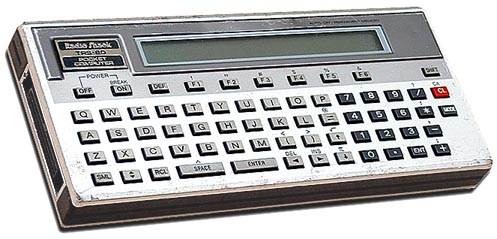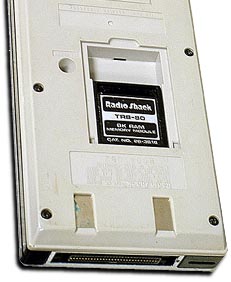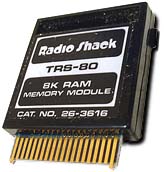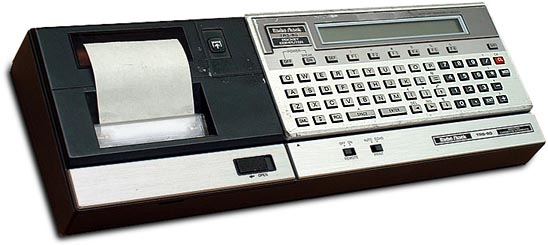|
|
|---|
| TRS-80 PC-2 Pocket Computer |
| Introduced: | January 1982 |
| Price: | US $280 |
| Weight: | 400g / 14 oz |
| CPU: | Sharp LH5801 @ 1.3Mhz |
| Memory: | ~2K RAM, ~10K max. |
| Display: | 26 character LCD display |
| Power: | 4 "AA" batteries |
| Storage: | Optional audio cassette |
| Peripherals: | Optional printer |
| OS: | BASIC in ROM |
| |
|---|
|
|
|

Radio Shack's second "pocket computer" is no pocket computer - it is much too large and heavy. Like the smaller and lighter original
PC-1, the PC-2 was also designed by Sharp, who released their own version,
the PC-1500.
With physical dimension which seem like a disadvantage, the software and additional features make up for it.
The PC-2 has a faster and more powerful CPU, a better BASIC programming language (built-in), and
expansion capabilities beyond those of the PC-1.
All of these improvements impose a high penalty - power consumption. The PC-2 requires 10X the
power to operate than the PC-1. As a result, it requires 4 "AA" batteries as opposed to the tiny
button-cell batteries of the PC-1.
 The RAM/ROM module slot on the back also adds greatly to its size. Application modules can be
installed here for instant access.
The RAM/ROM module slot on the back also adds greatly to its size. Application modules can be
installed here for instant access.
 These include:
Games
Statistics
Personal Finance
Business Finance
Investment Analysis
Chemistry Math
and more.
These include:
Games
Statistics
Personal Finance
Business Finance
Investment Analysis
Chemistry Math
and more.
Alternately, addition memory (RAM) can be installed for memory-intensive applications.
Radio Shack sold 4K and 8K RAM modules for the PC-2.

 While the PC-1 had an attachable dot-matrix printer for application print-outs and listings,
the PC-2 has a exciting 4-color plotter capable of printing both text and graphics. An example
is seen to the right.
While the PC-1 had an attachable dot-matrix printer for application print-outs and listings,
the PC-2 has a exciting 4-color plotter capable of printing both text and graphics. An example
is seen to the right.
 Above, you see the print-out magnified about 8X. The word "COMPUTER" is actually 20mm (3/4 inch) wide. This is just one example,
as the plotter can print text in 9 different sizes. The plotter draws the letters with tiny ink pens.
Above, you see the print-out magnified about 8X. The word "COMPUTER" is actually 20mm (3/4 inch) wide. This is just one example,
as the plotter can print text in 9 different sizes. The plotter draws the letters with tiny ink pens.
The plotter attachment also provides program loading, data storage and retrieval through a cassette interface.
The next pocket computer in the family, the PC-3 is truly a pocket computer.
Substantially smaller and lighter than the original PC-1, the PC-3 will easily fit in a shirt pocket for maximum portability.
|
|---|
History of the Radio Shack Computers |
- 1921: - Radio Shack begins as a one-store retail and mail-order company catering to
ham operators and electronics buffs.
- 1963: - Charles Tandy buys the chain of stores, and within two years turned a $4 million dollar
loss into a $20 million dollar profit.
- 1977: August - Radio Shack announces the TRS-80 Model I microcomputer for US$600.
- 1977: September - One month after launching the TRS-80, 10,000 are sold.
- 1979: May - Tandy/Radio Shack announces the TRS-80 Model II.
- 1979: October - Radio Shack begins shipping the TRS-80 Model II to users.
- 1980: July - Radio Shack introduces the TRS-80 Model III, priced from US$700 to US$2500.
- 1980: July - Radio Shack introduces the TRS-80 Color Computer, and sells for US$400.
- 1980: July - Radio Shack introduces the TRS-80 Pocket Computer. Price is US$230.
- 1981: January - Radio Shack ceases production of the TRS-80 Model I, and recalls units from the
US market, due to failure to meet new FCC radio-frequency interference regulations.
- 1982: January - Radio Shack introduces the TRS-80 Model 16, with 8-inch floppy drives, and
optional 8-MB hard drive.
- 1982: January - Radio Shack introduces the TRS-80 Pocket Computer, Model PC-2, for US$280.
- 1983: March - Radio Shack announces its TRS-80 Model 100 portable computer. Price is US$799 for
8KB version, to US$1134 for the 32KB version.
- 1983: May - Radio Shack introduces the TRS-80 Model 4, for US$2000.
- 1983: June - Radio Shack introduces the TRS-80 PC-3, for US$99.95.
- 1983: October - Tandy/Radio Shack announces the "transportable" TRS-80 Model 4P, for US$1800.
- 1983: Radio Shack introduces the TRS-80 Pocket Computer, Model PC-4, replacing the PC-1, for US$70.
- 1983: Tandy releases the TRS-80 Model 2000, which uses the Intel 80186 microprocessor.
- 1983: Radio Shack unveils the TRS-80 Model 12 at the CP/M '83 Show. Price is US$3200.
- 1985: March - Radio Shack introduces the Tandy 6000 multiuser system. It features Z80A and 68000
processors, 512 KB RAM, 80x24 text, graphics, 1.2-MB 8-inch
disk, optional 15 MB hard drive, TRS-DOS, or XENIX 3.0. It supports up to 9 users.
Source:
Chronology of Events in the History of Microcomputers
| |
|---|
|
Return to the Obsolete Technology Homepage

Copyright 2024
This page last updated on 05/08/2016 01:06:44
All logos and trademarks on this site are property of their respective owner.
|

 The RAM/ROM module slot on the back also adds greatly to its size. Application modules can be
installed here for instant access.
The RAM/ROM module slot on the back also adds greatly to its size. Application modules can be
installed here for instant access.
 These include:
These include:

